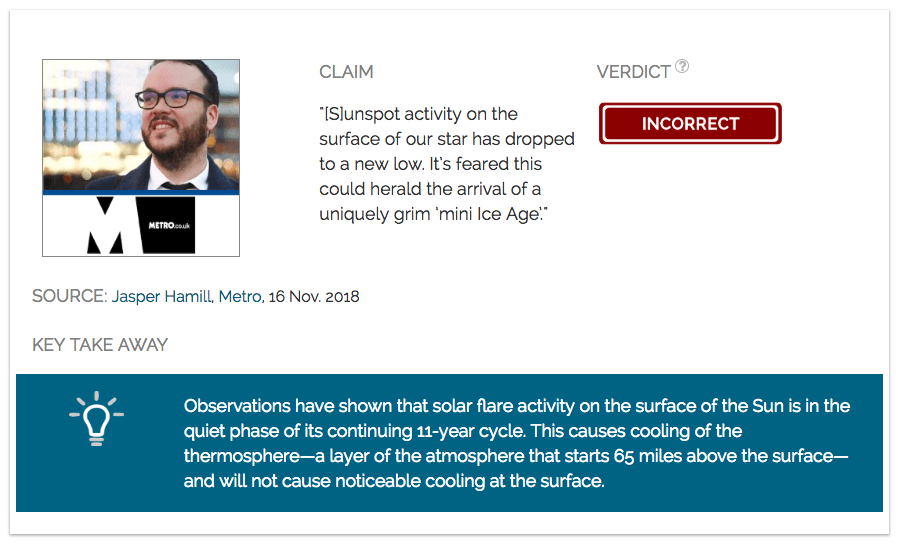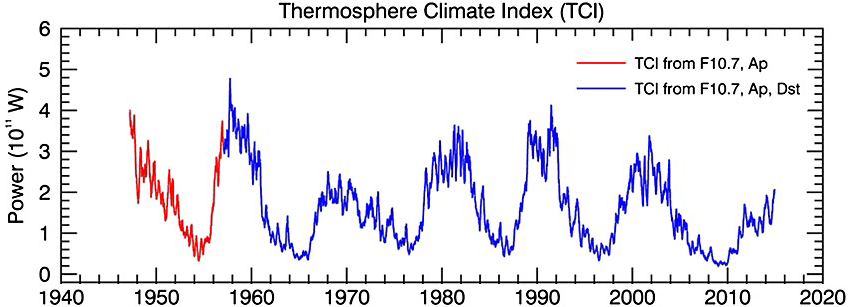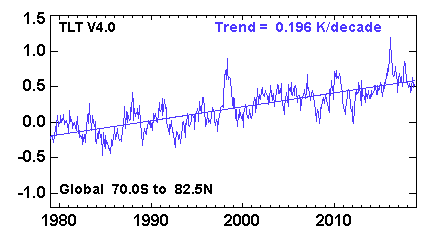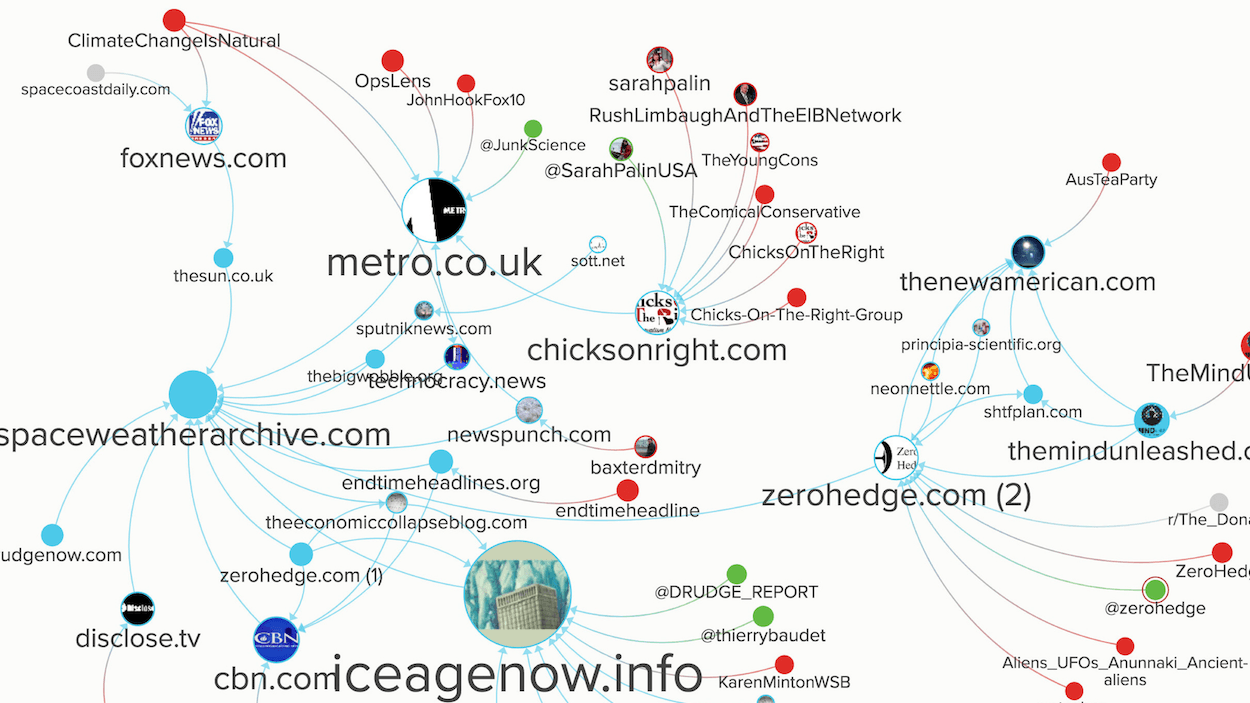
Recently, alarming claims that we are heading towards a “mini ice age” have been popping up across the web. This was the subject of a widely discussed Metro article titled “A mini ice age could be on the way which means it will get very, very cold”. Similar claims were also repeated without verification throughout a network of unreliable outlets for climate news including Sputnik, The Sun, Fox News, and numerous hyper-partisan blogs such as Zero Hedge, Principia Scientific, IceAgeNow, Alien-Star…
The stories claim to be based on a September 27th article at Space Weather Archive, in which NASA scientist Martin Mlynczak discusses the influence of current low solar activity on the Earth’s thermosphere—a layer of the atmosphere that begins about 65 miles above the surface.
The Metro journalist claimed that this drop in solar activity could cause a cooling at the Earth’s surface: “Sunspot activity on the surface of our star has dropped to a new low. It’s feared this could herald the arrival of a uniquely grim ‘mini Ice Age’.” NASA scientist Martin Mlynczak explained to Climate Feedback that headline claims of coming cold weather are false and result from a misunderstanding, as the temperature effect of this low solar activity is primarily felt in the far upper reaches of the outer atmosphere, and is not expected to have any effect on the surface temperatures we experience:
The claims such as those in the Metro article are false. If you check the original story at Space Weather [the source of the quotes], there is no mention of a mini ice age, nor is there any mention of consequences for weather and climate at Earth’s surface.To emphasize, the cooling effects we are seeing in Earth’s thermosphere are a result of the current solar minimum conditions. The thermosphere is the layer of Earth’s atmosphere beginning 65 miles above Earth’s surface and is highly sensitive to solar activity. There is no relationship between the natural cycle of cooling and warming in the thermosphere and the weather/climate at Earth’s surface. NASA and other climate researchers continue to see a warming trend in the troposphere, the layer of atmosphere closest to Earth’s surface. There is no inconsistency between the science findings of a warming troposphere [where we live] and the Thermosphere Climate Index described above in the Space Weather article.


A recurrent issue
Claims of an imminent “mini ice age” linked to solar activity appear frequently at certain outlets, as they make for attention-grabbing stories that purport to contradict projections of human-caused climate change. Scientists have debunked similar statements in the past. In July 2015, for instance, the Telegraph published an article titled “Earth heading for ‘mini ice age’ within 15 years”. And in 2016, the Heartland Institute published a booklet aimed at children in the US claiming that “the next few decades may be marked by global cooling rather than warming”.
These claims are based on a misunderstanding of what the Maunder minimum was, as explained by Prof Lockwood in response to the Telegraph article:
The term “mini ice age” is inherently misleading in the context of solar variations as it implies a global decrease in temperatures and at all times of year. This does not apply at all to the solar Maunder minimum. Temperature observations from central England show that summers during the Maunder minimum were, if anything, slightly warmer than average – indeed the third warmest summer in that record occurred in the middle of the Maunder minimum, just 2 years after the coldest winter. Hence there was certainly not the unremitting cold in the Maunder minimum that the term “mini ice age” implies. There is evidence that there was increased occurrence of cold winters during the Maunder minimum but this is an effect of jet stream behaviour specific to northern Europe and the USA and not a global ice age… Winters in northern Europe and the USA were colder but those in Greenland/Canada and southern Europe were warmer. This was not an “ice age” of any kind.
Finally, research shows that variations in solar activity are expected to only have a very moderate impact on global climate in the decades to come, as explained by Dr Feulner in response to the Heartland booklet:
While there are some indicators that future solar activity might indeed be lower, this will have little effect on global temperatures. See, for example, this RealClimate post based on Feulner and Rahmstorf (2010)1.
The results have been confirmed by a number of follow-up studies2-4.
While regional and seasonal effects might be larger, the expected global temperature response to a future grand solar minimum similar to the Maunder Minimum is a cooling of about 0.1°C. It should be pointed out that this cooling would occur on the background of current anthropogenic warming which is about a factor of 10 larger[…] It is also clear from these numbers that a future grand solar minimum (which would last only for a few decades anyway) would not save us from global warming. The marginal temperature differences between warming scenarios with and without a future Maunder Minimum is illustrated here:

Figure – Rise of global temperature for two different emission scenarios (A1B, red, and A2, magenta). The dashed lines show the slightly reduced warming in case a Maunder-like solar minimum should occur during the 21st century. The blue line represents global temperature data. Source: PIK.
- 1- Feulner and Rahmstorf (2010) On the effect of a new grand minimum of solar activity on the future climate on Earth, Geophysical Research Letters
- 2- Anet et al (2013) Impact of a potential 21st century “grand solar minimum” on surface temperatures and stratospheric ozone. Geophysical Research Letters [“although the solar minimum results in a reduced global warming, it cannot compensate continuing anthropogenic impacts.“]
- 3- Meehl (2013) Could a future “Grand Solar Minimum” like the Maunder Minimum stop global warming? Geophysical Research Letters [“a future grand solar minimum could slow down but not stop global warming.“]
- 4- Jones et al (2012) What influence will future solar activity changes over the 21st century have on projected global near-surface temperature changes? Journal of Geophysical Research Atmospheres. [“the possible mitigation potential for future solar activity changes is much smaller than the known uncertainties and ranges in the future anthropogenic response.“]
It is useful to note some common failures in these stories, which illustrate why the outlets publishing them are unreliable sources of information about climate change:
1) Misrepresentation of sources:
All these reports take the source quotes out of context, creating a new and misleading meaning. It would have been easy for any of these authors to contact the scientist and verify that they are interpreting his findings properly, as we did and science journalists do as a matter of routine professional practice.
2) Use of imprecise language:
Few of these stories explained that the cooling discussed was occurring in the thermosphere—much less what the thermosphere is. And by using terms such as “mini ice age”, they lead readers to think the scientist’s quotes refer to surface temperatures. For example, people who read that “it’s going to get very, very cold” are certainly not going to immediately guess that “it” is the thermosphere.
Responses to these stories on social media make it clear that the message many readers took away is completely inaccurate. The Facebook page ‘Climate Change is Natural’, for instance, shared the Metro article with the accompanying comment:
“Humanity is facing a long, cold winter which could see temperatures across the planet plunge to depressing lows. According to a NASA scientist…”
These stories are also being used to claim that global warming has stopped. For instance, a blogger (Steve Milloy) commented on Twitter while sharing the Metro article: “Nature poised to compel an end to global warming hysteria?”, while a Fox 10 News anchor commented, “I thought we were heading for apocalyptic global warming? These guys can’t seem to make up their minds…”
Several media outlets corrected their article
Following publication of our reviews, the Metro article was corrected (as well as the Sun and Fox News, which had published similar articles). The corrections make it clear that no “mini ice age” is imminent. Metro published a note saying, “This article has been amended since initial publication to remove the erroneous suggestion that the possibly record-breaking cooling of the thermosphere, located over 100km above the surface of the Earth, would have the effect on the troposphere of ‘a mini Ice Age’. We are happy to clarify that the record low temperatures reported as part of a natural cycle in solar activity are not inconsistent with current scientific findings of a warming troposphere, and apologise for any contrary impression given.”
Fox News clarified that “the Earth’s climate will remain unaffected”. However, most social media users who had seen the original articles have not be made aware that they were misled.

Read more about how that claim propagated online:
False claims of a coming ice age spread through ecosystem of unreliable news sites, blogs, and social media accounts

